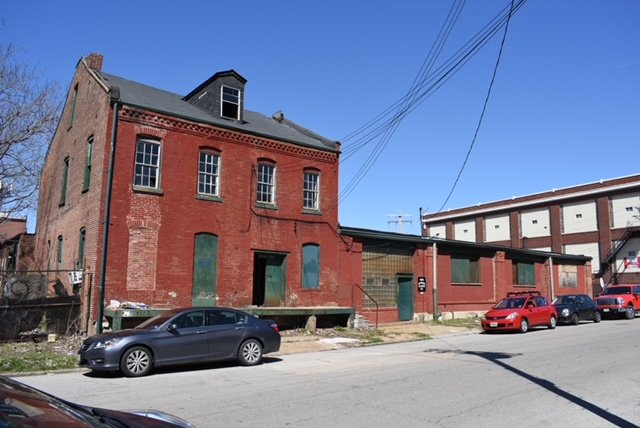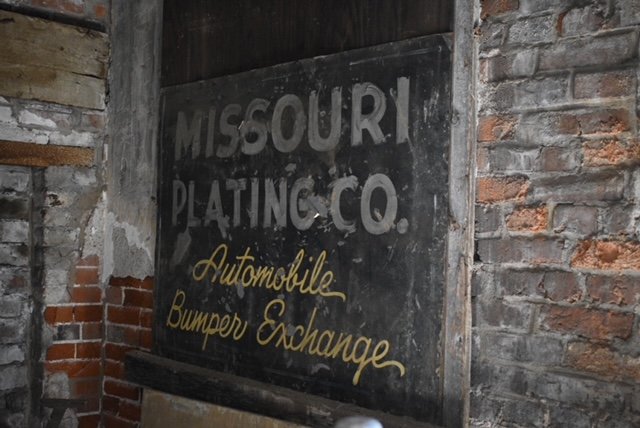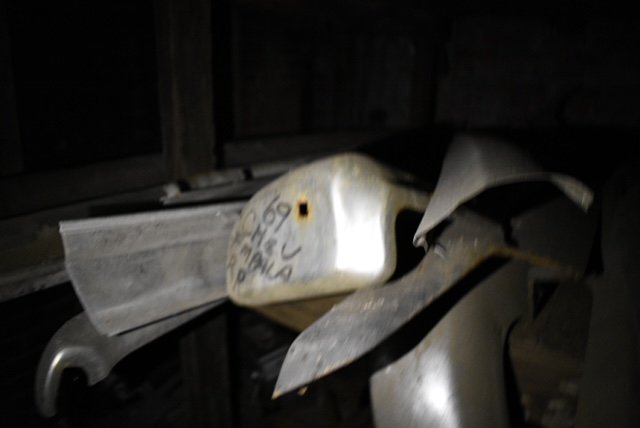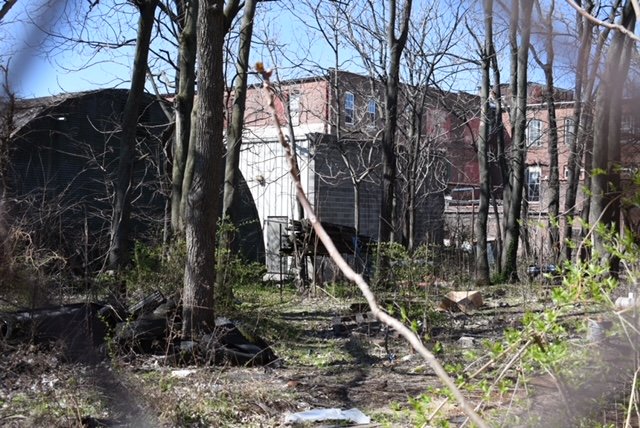When buildings are not maintained or occupied, they quickly become susceptible to the elements. Think of the extremes we experience here. An unoccupied home freezing and thawing over the winter and then baking under the summer heat and humidity year after year eroding the bones and chipping away at the insides.
A small hole in a roof or a couple missing bricks on a parapet can quickly let in rain water, exacerbating the problem. Water, the eraser of all man made things takes hold; the roof collapses, the studs are exposed and highly flammable and finally it falls.
The landfill is further loaded and usually, a vacant lot sits for years or decades following the collapse.
Further, consider the potential of harmful environmental or health issues some of these abandoned properties hold. St. Louis is an Industrial Era city, and the uses of some of our buildings tucked into our residential neighborhoods have dubious pasts.
I’ve watched residential, commercial and industrial buildings slowly decay for decades all over St. Louis from the Patch to Baden, Downtown to the West End. Even in the neighborhoods that most agree are gentrified, we have brick buildings that have been vacant for years, decades even. They are all over the place, usually mere feet away from residential and public spaces.
There is an eye-opening map from the St. Louis Vacancy Collaborative that documents all the vacant lots and buildings throughout St. Louis. Here’s just a snippet of the map in North St. Louis that shows the issues that face us after decades of disinvestment including white flight, redlining and now Black flight.
Most are not even secured or boarded up by their owners. The city-owned properties are usually no better, but they try. This means people can break in and squat or party in them. Which means susceptibility to further destruction in the form of fires. Arson and accidental fire, water and the other elements are likely going to win in these scenarios. Our old buildings were built quite well and stand a great chance of enduring for many generations if they are maintained, updated and lived in, but leave them vacant and/or open to the elements and people, and you have a recipe for disaster.
Each neglected and abandoned building has a story and a reason for being abandoned. Sometimes they are quite complicated, sometimes no one even knows why. The information is not readily available or reliable.
One thing that rings true, these buildings are rarely owned by people who live here. It is very easy to let your property decay and start to fall when you aren’t reminded of it daily or live next to it. It is easier to forget or let it rot when it is out of sight and out of mind. It’s rare to come across an abandoned, neglected property that someone in the neighborhood owns.
Take my neighborhood of 11 years, Fox Park. I’ve watched buildings crumble to the elements in my time here.
Some losses hit harder than others. I was really upset by one on Geyer Avenue that burned to the ground. A gorgeous building that finally fell to a long history of abandonment and neglect succumbing to squatters setting fire to it either accidentally or on purpose.
I wrote about this back in 2018, walking my neighborhood with a camera and documenting the obvious abandoned properties. I was pretty angry that this level of neglect was still happening even in a desirable, rapidly improving place. Investment comes eventually, but it happens so slow that many historic, gorgeous homes will fall in the decades it takes for St. Louis neighborhoods to gentrify vs. the overnight gentrification and investment you see in wealthy cities.
I regretted the vitriol that I let seep through in that story. But, it came from a genuine place. I followed up that story a couple years later. We were still losing properties to the elements via gross neglect. But, I wanted to show that slowly, some properties were being purchased by those with means and desire to bring them back to inhabited, beautiful places. This ranges from developers wanting to turn a quick profit to committed owners/rehabbers who plan to live in the building, or sell it to someone committed to St. Louis.
But I posed the question: “what can the average citizen do about abandonment and neglect in their neighborhood”. I tried to spin a bit of a positive narrative, but I was left with the feeling of hopelessness and being part of the problem and not the solution by just sitting on the sidelines and watching the decay take hold until the wrecking ball finally comes and sends our resources to the landfill…then complaining from behind my keyboard and camera lens.
“At the end of the day, I can’t answer the question of ‘What can the average citizen do’ to help fight vacancy and abandonment in our neighborhoods.
I guess it’s take matters into your own hands and buy a property or try to advocate for a CDC that can affect real change.
I don’t have the answers.
If you have success stories of neighbors banding together to fight vacancy and abandonment and how to address trespassing, I would like to know your story. Feel free to contact us here.
The thing I do know, a lot of our problems would subside if we just had one thing: more people who care and want to live here and root down and be nice, caring neighbors who want better for all. People who can and are willing to do basic home maintenance. We need those people more than anything, not speculators and suburban investors sitting on properties for years, sometime decades or gutting them and flipping them.
”
I tried to show that there is hope when we hit a hot housing market and Fox Park is lucky enough to be a neighborhood that people want to live and invest in. It’s getting better, but we are still susceptible to losing more buildings as time marches on.
I felt a little better by publishing that second story, but the articles had an ancillary, unexpected outcome.
Enter Peter Hoffman, Managing Attorney with the Neighborhood Vacancy Initiative Legal Services of Eastern Missouri (LSEM) who volunteers with the St. Louis Vacancy Collaborative. Peter reached out to me in May, 2020 after reading the articles above and offered to meet and talk.
I was feeling hopeful once again, in that something might actually happen…turning talk and frustration into action and positivity.
A Zoom call was organized in July, 2020 with some colleagues at Peter’s firm as well as the Associate Dean for the Experiential Education and Supervisor of Entrepreneurship and Community Development Clinic at St. Louis University Law School and a member of the Community Builders Network of Metro St. Louis.
I can usually tell when I’m either surrounded by well-intentioned people or when I’m swimming in a pool of sharks. There are certain types of ego and personality that make me shut down when it comes to urban or civic dealings. Peter came across as a genuine soul, someone who truly cares and wants to help average citizens forge a path toward positive outcomes. I can sense when someone is a talker vs. a doer. Peter and his team struck me as the latter, so I wanted to forge a relationship and take advantage of his team’s desired mission, talents and resources with the Vacancy Collaborative.
“The St. Louis Vacancy Collaborative (VC) is a coalition of community members, private and non-profit stakeholders, and City agencies committed to reducing vacant property in St. Louis.
The VC helps to coordinate existing vacancy efforts under one umbrella and empowers the public and private sectors to work together toward solutions. We convene committees and working groups to facilitate systemic change, advance new policies, share success stories, and support neighborhood-centric solutions.”
Peter wanted to collaborate and help in Fox Park by offering legal support to understand the history and current ownership landscape of these abandoned properties.
We decided to start by taking an inventory of the neighborhood’s abandoned properties. Now, I didn’t do this online, I did it by walking the sidewalks, street by street looking for boarded up or completely vacant and/or open to the elements buildings.
I now had a spreadsheet of addresses, 21 in total, yet this is likely not a holistic count. Per the 2020 Census data, Fox Park has 1,393 total housing units, 274 of which are vacant. My list was likely the worst of the worst, the ones clearly abandoned and in a state of severe neglect from the street view.
Peter offered up his time and resources to do a legal search into all properties on the list. We sorted them into categories based on the ownership and tax payment status.
We narrowed the list down to seven properties that might be the most endangered and susceptible to further decay and abandonment. We knew the title and legal issues would be complex, and it was recommended that we find a responsible, actionable owner to take possession of the property.
Enter DeSales Community Development. I reached out to DeSales Executive Director Tom Pickel and Becky Reinhart, Assistant Director at DeSales to share our collaboration with LSEM and the Neighborhood Vacancy Initiative. I was once again surrounded by smart, well-intentioned doers.
In the time that has passed, Tom has announced he will retire at the end of the year, having served as Executive Director for 35 years. Becky will be his successor. Seems we are in good hands.
DeSales jumped in eagerly. There was no red tape, no vetting process, no review processes, no ego. They literally said yes, this is fantastic, how can we help?
The first step was to reach out to the owners on record.
DeSales contacted the owners of these properties one by one. Some were called, some were sent letters. DeSales reported back with a patchwork of outcomes from good news of rehabs on the way, recent sales to a developer, to some that did not reply.
A property at 2501 Texas Avenue was selected for action.
This is an interesting property that used to be an automobile chrome bumper plating business. Per city records, the building is zoned as a warehouse and includes 2501 - 2515 Texas Avenue.
The oldest part of the building dates to at least 1875 and it used to be surrounded by a giant sinkhole. By the 1900s it was being used as a metal works and lacquering shop. The site and buildings have an interesting past. Historian Chris Naffziger researched the property for DeSales. Here are some of Naffziger’s findings, published here with his permission:
“The original house facing Texas Avenue 2509, which was built as a duplex no later than 1875, but perhaps even as early as 1865 or 1868, when Baldwin’s Estate was platted out. It seems like the house was built along the lines of the lots laid out in the subdivision, and stylically it looks like it would have been built in that period. The 1876 Compton and Dry’s Pictorial St. Louis, which was observed in 1875, clearly shows the duplex surrounded by a large lake/sinkhole which has now been filled in. The house surely functioned as residential use for workers at nearby agricultural or other light industrial occupations in the still largely suburban area in 1875-6.
By 1896, however, the Whipple Fire Insurance map shows a dramatically changed neighborhood around the duplex. There are more houses along the west side of Texas, and the Koken Barber Supply Company has expanded onto the land of the former sinkhole, probably not wanting to risk building large structures on the unstable soil yet. Most importantly, the duplex has been subsumed into the Koken business, with the front house being converted into a tin shop, and a workshop has been constructed in the backyard labeled “Japan Ho[use],” complete with a “Japan Oven.” The process of Japanning was a form of laquerring for the protection of metal objects and used toxic chemicals.
In 1909, the Sanborn Fire Insurance map shows the continued use of the property as a tin shop on the first floor and storage on the second floor of the duplex, while the large workshop in back is now labeled as a paint shop. The Japanning Oven is now labeled as an enameling oven. The large open lot to the north is still vacant, and the large one story building has not been built yet, and neither has the structure that protrudes from the roofline in the northwest corner of the complex. I would estimate those structures were built at some point between 1909 and 1920.
I found an easement for the party wall for the duplex between a foundry and a Henry Gross from 1939, so it seems the plating business can be established as being in operational early as that. Recollections from a Compton Heights native stated he paid $1.00 to have his bicycle fender chrome plated in the 1950s, so that further confirms early operations. A directory also stated that “Heinz Gross,” who is most likely the ancestor of later owners of the bumper plating business, owned the property in 1969.”
1876 Compton and Dry’s Pictorial St. Louis
1896 Whipple Fire Insurance Maps
1909 Sanborn Map
I asked Peter to describe the next steps.
“The first step a community organization can take to address a vacant nuisance property is to contact the owner themselves. With the assistance of Legal Services, DeSales was able to determine that the ownership for the Texas property was not so clear - it involved a dissolved LLC and some family members who had likely inherited an interest at some point.”
This fractured title, what Hoffman refers to as “legal blight” is often the norm when it comes to vacant and abandoned buildings, “without clear title an owner can’t sell the property, they can’t get a loan to repair it, so they just abandon it”, he said.
Another issue likely contributing to this property’s abandonment was its condition, more on that later…
With the letter from DeSales going out without any response from the owner, DeSales formally retained Legal Services to represent them in a court action to either compel the owner to make improvements or have the title transferred to someone who could.
Hoffman confirmed the fractured ownership with a local title company and then sent a legally-required sixty day notice of DeSales intent to file a lawsuit. It prompted a response.
“One of the family members retained a lawyer for a brief moment, who contacted me to ask about the lawsuit. He was provided an opportunity to take action - for whatever reason he did not, and the lawsuit went forward. Maybe his lawyer told him that this was actually a benefit to him, to let this property go. Maybe it was the cost of defending the lawsuit or making repairs that is the deterrent, you just never know,” said Hoffman.
“Once the lawsuit was filed and every person, corporate and natural, was given personal notice of the lawsuit, the next step of the process was to enter the property under the order of the Court and determine exactly the extent of disrepair - and have DeSales create a plan for addressing those problems. That’s where the fun starts…”
I asked Becky Reinhart to recall DeSales involvement and speak to the project and how it fits into DeSales mission as a Community Development Corporation.
Per Reinhart, “When Mark brought this property to our attention, along with a number of other vacant and deteriorating properties in the neighborhood, we were familiar with this particular building and its exterior conditions. We knew there had been a fire in part of the building, and that it had been non-operational at least since that time. Figuring out solutions for vacant and abandoned properties is a big part of what DeSales does and has done for its 45 year history - we’re no strangers to vacant and dilapidated buildings. Over the years, DeSales has developed over 250 units of housing through historic preservation and new construction. We’ve also collaborated with other developers and owner-occupant rehabbers to facilitate the preservation of many more vacant and abandoned properties in the Fox Park/Tower Grove East/Benton Park West area. Once we gained entry to this building and saw the conditions inside, however, we realized that this was unlike any property we’d previously had a role in redeveloping.”
When we had the authority to enter the property to take a look and get some photos, I was invited to tag along. Let me tell you, I’ve been in quite a few vacant buildings in my 27 years in St. Louis. I have some acquaintances who are rehabbers and they’ve invited me into some buildings they were rebuilding that were on the verge of being too far gone. It’s amazing what can be saved when the bones are solid and the skill, gumption and money is there to invest.
The property at 2501 Texas was not salvageable. It was also contaminated with several 55 gallon drums of various chemicals including copper cyanide.
It was almost as if the chrome plating business just closed up shop and walked away. There were half filled sodas and invoices and other paperwork still in the office. The chrome bumpers were there, the equipment was there…and so were the copious amounts of chemicals, some toxic.
The roof was not there, however. The stairs were not stable, so I didn’t feel comfortable going upstairs. It was pretty bad, one of the worst I’ve seen for what it’s worth.
Per Hoffman, “The severity of neglect here was so enormous, that DeSales had to reach out to State and Federal authorities for assistance.
The rehabilitation plan presented to the Court by DeSales allowed for the Environmental Protection Agency to enter upon the Property to remediate the contamination.
Once environmental remediation is completed, DeSales will take over the remainder of the work, contracting for the demolition of the property and soil testing before finally working toward paving the parcels for parking for the adjacent residential units.”
Per Reinhart, DeSales is working to rehab and develop other properties in this part of the neighborhood.
“In 2016, 2528 Texas was listed for sale and DeSales purchased the property and some property that is now Rung for Women’s campus. They wanted to ensure the outcomes of the buildings and properties would benefit the neighborhood at large. Originally, 2528 Texas was to be a hub for manufacturers, but it did not materialize. The property was sold to Blackline Development who plan to convert the building to residential.”
In July, 2021, NextSTL reported on plans to convert a nearby industrial building into 78 apartments.
While rehabbing our historic buildings is always the ideal outcome, it is not always feasible. I felt it important to document an example of where a rehab is not in the cards. The ownership complexity, extreme environmental contamination, advanced structural decay of the buildings themselves proved renovation to be too much for a Community Development Corporation to take on.
The code violations had to be remedied, and that included demolition of the building.
Upon demo, the lot would be graded, initially paved for a parking lot for use by nearby apartments and potentially open for future development. DeSales would maintain ownership of the lots, not the owner/developer of the apartments, so future development opportunities could be in the cards with control of the future use of the space to be controlled by our CDC.
DeSales contacted the U.S. Environmental Protection Agency (EPA) who had designated the properties as a superfund site.
U.S. EPA on site for superfund cleanup
“EPA’s Superfund program is responsible for cleaning up some of the nation’s most contaminated land and responding to environmental emergencies, oil spills and natural disasters. To protect public health and the environment, the Superfund program focuses on making a visible and lasting difference in communities, ensuring that people can live and work in healthy, vibrant places.”
The EPA jumped in to clean up the site. I the meantime, the EPA has nearly completed their removal of the hazardous materials and will issue a final, comprehensive report including all findings and lab results this summer.
The upfront investigative work, lawsuits and transfer of property into the hands of a responsible owner is something that never could have happened without LSEM and DeSales working together with an average citizen like myself to reach a conclusion. Since bringing this property to their attention, DeSales and Legal Services, with pro bono attorney support from Gray Ritter Graham, have started the process on another four properties, each assuredly with a story as unique as the Texas property.
Just as every property has a different history and becomes abandoned for different reasons, each also has its own trajectory as to what's possible. For every demolition there's a renovation. Legal Services currently serves 16 different community organizations city-wide and opens more than forty cases a year to address vacant and abandoned properties - both north and south of our divided city.
So when you walk by this corner and ask why did they tear that building down and why is there a surface parking lot on this corner, you can read this for the explanation.
We tried and I am at peace with the outcome. There are hundreds of properties just like this one, all over St. Louis. For some, rehabbing or development into new housing is an option.
Neighborhoods are more than just buildings. The health and safety of people who live in the community is also worth protecting and preserving. Imagine if this building succumbed to ANOTHER fire, the toxic potential for the residents and business workers could be severe.
Whether the outcome is a renovation or a demolition, there have to be people that do the work.
I am hopeful knowing that organizations like the Neighborhood Vacancy Initiative and DeSales are willing to jump in and help navigate these very complicated and frustrating issues of vacancy and abandonment.
If you find yourself frustrated by the years of abandonment and vacancy that exists in our neighborhoods, I hope this story sheds some light on a positive interaction and outcome that was attainable for the most average of citizens, once I got connected to people who care and put in the hardest of work.
When it comes to spending public ARPA dollars and NFL lawsuit money in the future, I see community development corporations, service providers like Legal Services, and coordinating coalitions like the St. Louis Vacancy Collaborative as a noble use of funds toward seeking long term solutions to a very complicated problem.
Cheers to all those working so hard behind the scenes to provide outcomes that are a step in the right direction.
On to the next property.













